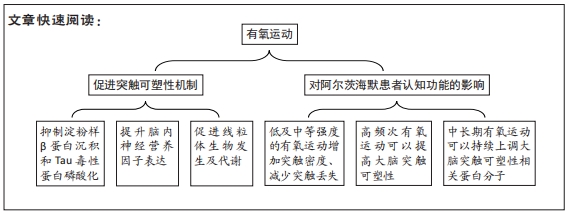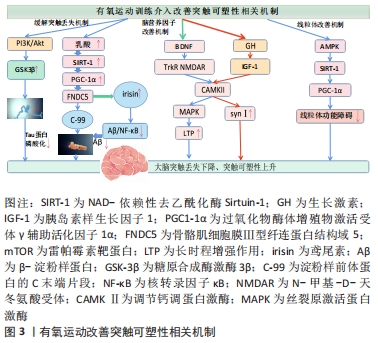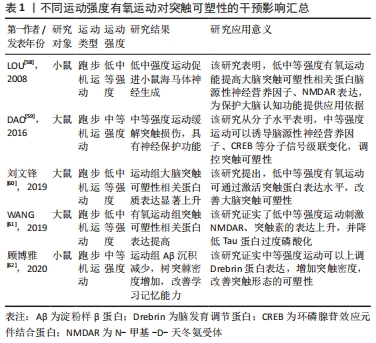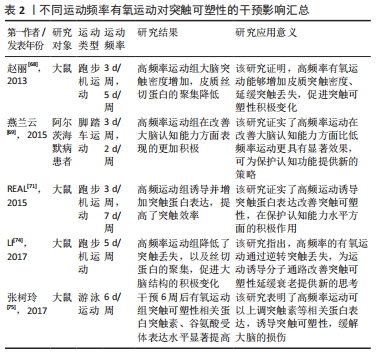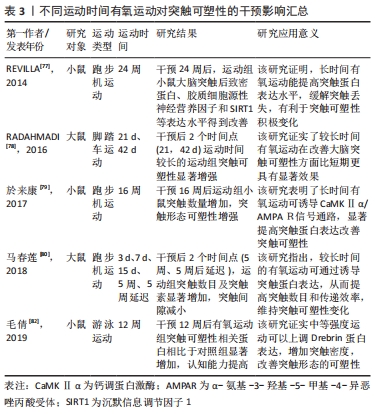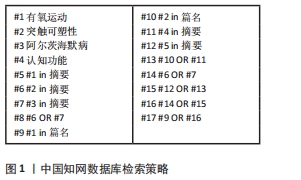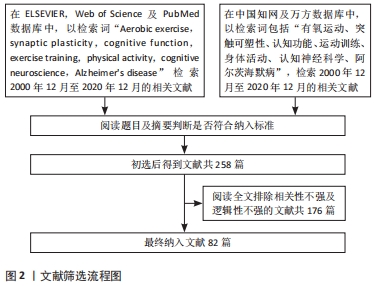[1] SERRANO-POZO A, FROSCH MP, MASLIAH E, et al. Neuropathological alterations in Alzheimer disease. Cold Spring Harb Perspect Med. 2011; 1(1):a006189.
[2] Lu Y, Dong Y, Tucker D, et al. Treadmill exercise exerts neuroprotection and regulates microglial polarization and oxidative stress in a streptozotocin-induced rat model of sporadic alzheimer’s disease. J Alzheimer’s Dis. 2017;56(4):1469-1484.
[3] MORENO-JIMÉNEZ EP, FLOR-GARCÍA M, TERREROS-RONCAL J, et al. Adult hippocampal neurogenesis is abundant in neurologically healthy subjects and drops sharply in patients with Alzheimer’s disease. Nat Med. 2019;25(4):554-560.
[4] WANG H, XU X, GAO J, et al. Enriched environment and so‐cial isolation affect cognition ability via altering excitatory and in‐hibitory synaptic density in mice hippocampus. Neurochem Res. 2020. doi: 10.1007/s11064-020-03102-2.
[5] LEE SH, LUTZ D, MOSSALAM M, et al. Presenilins regulate synaptic plasticity and mitochondrial calcium homeostasis in the hippocampal mossy fiberpathway. Mol Neurodegener. 2017;12(1):48.
[6] ZHANG Y, LI P, FENG J, et al. Dysfunction of NMDA receptors in Alzheimer’s disease. Neurol Sci. 2016;37(7):1039-1047.
[7] HOFFMANN K, SOBOL NA, FREDERIKSEN KS, et al. Moderate-to-high intensity physical exercise in patients with Alzheimer’s disease: a randomized controlled trial. J Alzheimers Dis. 2016;50(2):443-453.
[8] RAJENDRAN L, PAOLICELLI RC. Microglia-mediated synapse loss in alzheimer’s disease. J Neurosci. 2018;38(12):2911-2919.
[9] GOETZL EJ, KAPOGIANNIS D, SCHWARTZ JB, et al. Decreased synaptic proteins in neuronal exosomes of frontotemporal dementia and Alzheimer’s disease. FASEB J. 2016;30(12):4141-4148.
[10] 刘慧莉,赵刚.运动、阿尔茨海默病与突触可塑性[J].中国康复理论与实践,2012,18(3):244-246.
[11] KAMAT PK, KALANI A, RAI S, et al. Mechanism of oxidative stress and synapse dysfunction in the pathogenesis of alzheimer’s disease: understanding the therapeutics strategies. Mol Neurobiol. 2016;53(1): 648-661.
[12] LAMBERT MP, BARLOW AK, CHROMY BA, et al. Diffusible, nonfibrillar ligands derived from Ab1–42 are potent central nervous system neurotoxins. Proc Natl Acad Sci U S A. 1998;95:6448-6453.
[13] SHANKAR GM, BLOODGOOD BL, TOWNSEND M, et al. Natural oligomers of the Alzheimer amyloid-beta protein induce reversible synapse loss by modulating an NMDA-type glutamate receptor-dependent signaling pathway. J Neurosci. 2007;27(11):2866-2875.
[14] TÖNNIES E, TRUSHINA E. Oxidative stress, synaptic dysfunction, and Alzheimer’s disease. J Alzheimers Dis. 2017;57(4):1105-1121.
[15] ZEMPEL H, MANDELKOW E. Lost after translation: missorting of Tau protein and consequences for Alzheimer disease. Trends Neurosci. 2014;37(12):721-732.
[16] KOO JH, KANG EB, OH YS, et al. Treadmill exercise decreases amyloid-β burden possibly via activation of SIRT-1 signaling in a mouse model of Alzheimer’s disease. Exp Neurol. 2017;288:142-152.
[17] EL HAYEK L, KHALIFEH M, ZIBARA V, et al. Lactate mediates the effects of exercise on learning and memory through SIRT1-dependent activation of hippocampal brain-derived neurotrophic factor (BDNF). J Neurosci. 2019;39(13):2369-2382.
[18] SANCHIS-GOMAR F, PEREZ-QUILIS C. The p38-PGC-1α-irisin-betatrophin axis: exploring new pathways in insulin resistance. Adipocyte. 2014; 3(1):67-68.
[19] LOURENCO MV, FROZZA RL, DE FREITAS GB, et al. Exercise-linked FNDC5/irisin rescues synaptic plasticity and memory defects in Alzheimer’s models. Nat Med. 2019;25(1):165-175.
[20] 邓雨婷,马春莲,杨翼.Irisin:运动改善突触可塑性缓解阿尔茨海默症认知下降的新靶点[J].中国体育科技,2020,56(9):30-36.
[21] 房国梁,田野,赵杰修,等.有氧运动对肥胖大鼠海马组织tau蛋白磷酸化水平及PI3K/Akt信号通路的影响[J].中国运动医学杂志, 2017,36(5):375-382.
[22] 韩鹏.有氧运动对APP/PS1小鼠中枢GSK3活性及Tau蛋白的影响[D].北京:北京体育大学,2018.
[23] LOPRINZI PD, FRITH E. A brief primer on the mediational role of BDNF in the exercise-memory link. Clin Physiol Funct Imaging. 2019;39(1):9-14.
[24] MOHAMMADI A, AMOOEIAN VG, RASHIDI E. Dysfunction in brain-derived neurotrophic factor signaling pathway and susceptibility to schizophrenia, parkinson’s and Alzheimer’s diseases. Curr Gene Ther. 2018;18(1):45-63.
[25] ROTHMAN SM, MATTSON MP. Activity-dependent, stress-responsive BDNF signaling and the quest for optimal brain health and resilience throughout the lifespan. Neuroscience. 2013;239:228-240.
[26] QIN XY, CAO C, CAWLEY NX, et al. Decreased peripheral brain-derived neurotrophic factor levels in Alzheimer’s disease: a meta-analysis study (N=7277). Mol Psychiatry. 2017;22(2):312-320.
[27] 付燕,谢攀,李雪,等.长期有氧运动对大鼠脑衰老过程中学习记忆与海马BDNF表达的影响[J].中国运动医学杂志,2015,34(8):750-756.
[28] 刘瑾彦,刘向云,陈佩杰,等.易筋经对老年人认知功能和外周血BDNF水平的影响[J].上海体育学院学报,2018,42(2):109-112.
[29] LEE HK, TAKAMIYA K, HAN JS, et al. Phosphorylation of the AMPA receptor GluR1 subunit is required for synaptic plasticity and retention of spatial memory. Cell. 2003;112(5):631-643.
[30] YU Q, LI X, WANG J, et al. Effect of exercise training on long-term potentiation and NMDA receptor channels in rats with cerebral infarction. Exp Ther Med. 2013;6(6):1431-1436.
[31] DAO AT, ZAGAAR MA, ALKADHI KA. Moderate treadmill exercise protects synaptic plasticity of the dentate gyrus and related signaling cascade in a rat model of Alzheimer’s disease. Mol Neurobiol. 2015; 52(3):1067-1076.
[32] PLÁTENÍK J, KURAMOTO N, YONEDA Y. Molecular mechanisms associated with long-term consolidation of the NMDA signals. Life Sci. 2000;67(4):335-364.
[33] HONG YP, LEE HC, KIM HT. Treadmill exercise after social isolation increases the levels of NGF, BDNF, and synapsin I to induce survival of neurons in the hippocampus, and improves depression-like behavior. J Exerc Nutrition Biochem. 2015;19(1):11-18.
[34] MUTLU O, GUMUSLU E, KOKTURK S, et al. Effects of chronic administration of adipokinetic and hypertrehalosemic hormone on animal behavior, BDNF, and CREB expression in the hippocampus and neurogenesis in mice. Fund Clin Pharmacol. 2016;30(1):4-13.
[35] STREET ME, SMERIERI A, MONTANINI L, et al. Interactions among pro-inflammatory cytokines, IGF system and thyroid function in pre-pubertal obese subjects. J Biol Regul Homeost Agents. 2013;27(1):259-266.
[36] AYADI AE, ZIGMOND MJ, SMITH AD. IGF-1 protects dopamine neurons against oxidative stress: association with changes in phosphokinases. Exp Brain Res. 2016;234(7):1863-1873.
[37] FENG X, HUANG D, LU X, et al. Insulin-like growth factor 1 can promote proliferation and osteogenic differentiation of human dental pulp stem cells via mTOR pathway. Dev Growth Differ. 2014;56(9):615-624.
[38] FRYSTYK J. Exercise and the growth hormone-insulin-like growth factor axis. Med Sci Sports Exerc. 2010;42(1):58-66.
[39] STEIN AM, SILVA TMV, COELHO FGM, et al. Physical exercise, IGF-1 and cognition A systematic review of experimental studies in the elderly. Dement Neuropsychol. 2018;12(2):114-122.
[40] HÄKKINEN K, PAKARINEN A, KRAEMER WJ, et al. Selective muscle hypertrophy, changes in EMG and force, and serum hormones during strength training in older women. J Appl Physiol. 2001;91(2):569-580.
[41] MAASS A, DÜZEL S, BRIGADSKI T, et al. Relationships of peripheral IGF-1, VEGF and BDNF levels to exercise-related changes in memory, hippocampal perfusion and volumes in older adults. Neuroimage. 2016;131:142-154.
[42] 俞嘉玲,马黎,马兰,等. 2014.自主跑轮运动上调成年小鼠海马齿状回区细胞增殖及BDNF、IGF1和WNT4的表达水平[J].生理学报,2014,66(5):559-568.
[43] VANZELLA C, NEVES JD, VIZUETE AF, et al. Treadmill running prevents age-related memory deficit and alters neurotrophic factors and oxidative damage in the hippocampus of Wistar rats. Behav Brain Res. 2017;334:78-85.
[44] PLOUGHMAN M, GRANTER-BUTTON S, CHERNENKO G, et al. Endurance exercise regimens induce differential effects on brain-derived neurotrophic factor, synapsin-I and insulin-like growth factor I after focal ischemia. Neuroscience. 2005;136(4):991-1001.
[45] OGUNDELE OM, PARDO J, FRANCIS J, et al. A Putative mechanism of age-related synaptic dysfunction based on the impact of IGF-1 receptor signaling on synaptic CaMKⅡα phosphorylation. Front Neuroanat. 2018;12:35.
[46] SHEPHERD GM, HARRIS KM. Three-dimensional structure and composition of CA3-->CA1 axons in rat hippocampal slices: implications for presynaptic connectivity and compartmentalization. J Neurosci. 1998;18(20):8300-8310.
[47] MATTSON MP, LIU D. Mitochondrial potassium channels and uncoupling proteins in synaptic plasticity and neuronal cell death. Biochem Biophys Res Commun. 2003;304(3):539-549.
[48] ONYANGO IG, LU J, RODOVA M, et al. Regulation of neuron mitochondrial biogenesis and relevance to brain health. Biochim Biophys Acta. 2010; 1802(1):228-234.
[49] FERNANDEZ-MARCOS PJ, AUWERX J. Regulation of PGC-1α, a nodal regulator of mitochondrial biogenesis. Am J Clin Nutr. 2011;93(4): 884S-890S.
[50] BULER M, AATSINKI SM, IZZI V, et al. SIRT5 is under the control of PGC-1α and AMPK and is involved in regulation of mitochondrial energy metabolism. FASEB J. 2014;28(7):3225-3237.
[51] BAYOD S, GUZMÁN-BRAMBILA C, SANCHEZ-ROIGE S, et al. Voluntary exercise promotes beneficial anti-aging mechanisms in SAMP8 female brain. J Mol Neurosci. 2015;55(2):525-532.
[52] KOO JH, KANG EB, OH YS, et al. Treadmill exercise decreases amyloid-β burden possibly via activation of SIRT-1 signaling in a mouse model of Alzheimer’s disease. Exp Neurol. 2017;288:142-152.
[53] AZIMI M, GHARAKHANLOU R, NAGHDI N, et al. Moderate treadmill exercise ameliorates amyloid-β-induced learning and memory impairment, possibly via increasing AMPK activity and up-regulation of the PGC-1α/FNDC5/BDNF pathway. Peptides. 2018;102:78-88.
[54] BRIONES TL, SUH E, JOZSA L, et al. Changes in number of synapses and mitochondria in presynaptic terminals in the dentate gyrus following cerebral ischemia and rehabilitation training. Brain Res. 2005; 1033(1):51-57.
[55] KOŠČAK TIVADAR B. Physical activity improves cognition: possible explanations. Biogerontology. 2017;18(4):477-483.
[56] GHODRATI-JALDBAKHAN S, AHMADALIPOUR A, RASHIDY-POUR A, et al. Low- and high-intensity treadmill exercise attenuates chronic morphine-induced anxiogenesis and memory impairment but not reductions in hippocampal BDNF in female rats. Brain Res. 2017;1663:20-28.
[57] ORMEROD BK, LEE TT, GALEA LA. Estradiol initially enhances but subsequently suppresses (via adrenal steroids) granule cell proliferation in the dentate gyrus of adult female rats. J Neurobiol. 2003;55(2):247-260.
[58] LOU SJ, LIU JY, CHANG H, et al. Hippocampal neurogenesis and gene expression depend on exercise intensity in juvenile rats. Brain Res. 2008;1210:48-55.
[59] DAO AT, ZAGAAR MA, LEVINE AT, et al. Comparison of the effect of exercise on late-phase LTP of the dentate gyrus and CA1 of Alzheimer’s disease model. Mol Neurobiol. 2016;53(10):6859-6868.
[60] 刘文锋,刘少鹏,傅让,等.耐力运动对增龄大鼠脑皮层突触可塑性的影响及相关调控机制[J].中国应用生理学杂志,2019,35(4):8.
[61] WANG Q, HU J, LIU Y, et al. Aerobic exercise improves synaptic-related proteins of diabetic rats by inhibiting FOXO1/NF-κB/NLRP3 inflammatory signaling pathway and ameliorating PI3K/Akt insulin signaling pathway. J Mol Neurosci. 2019;69(1):28-38.
[62] 顾博雅,高姗姗,赵丽.有氧运动对调节AD模型小鼠海马Ras/Drebrin增加树突棘可塑性分析[J].北京体育大学学报,2020,43(1): 126-133.
[63] KIM HJ, LEE HJ, SO B, et al. Effect of aerobic training and resistance training on circulating irisin level and their association with change of body composition in overweight/obese adults: a pilot study. Physiol Res. 2016;65(2):271-279.
[64] LI J, LIU Y, LIU B, et al. Mechanisms of aerobic exercise upregulating the expression of hippocampal synaptic plasticity-associated proteins in diabetic rats. Neural Plast. 2019;2019:7920540.
[65] INOUE K, HANAOKA Y, NISHIJIMA T, et al. Long-term mild exercise training enhances hippocampus-dependent memory in rats. Int J Sports Med. 2015;36(4):280-285.
[66] LUCIA A, RUIZ JR. Exercise is beneficial for patients with Alzheimer’s disease: a call for action. Br J Sports Med. 2011;45(6):468-469.
[67] 刘军,刘仁仪,叶星.运动对阿尔茨海默病患者认知功能干预效果的meta分析[J].上海体育学院学报,2020,44(10):58-67.
[68] 赵丽,李岩,顾博雅.有氧运动调节Rho/cofilin信号改善衰老大鼠皮质突触丢失[J].北京体育大学学报, 2013,36(11):61-65, 69.
[69] 燕兰云,王蔚,沈飞飞,等.不同训练时间的有氧运动干预轻中度阿尔茨海默病的临床研究[J].中国康复医学杂志,2015,30(8):771-776.
[70] 刘银,王彤,朱奕,等.中等强度有氧运动改善阿尔茨海默病患者认知功能的研究[J].中国康复,2017,32(5):386-389.
[71] REAL CC, GARCIA PC, BRITTO LRG, et al. Different protocols of treadmill exercise induce distinct neuroplastic effects in rat brain motor areas. Brain Res. 2015;1624:188-198.
[72] CAI M, WANG H, LI JJ, et al. The signaling mechanisms of hippocampal endoplasmic reticulum stress affecting neuronal plasticity-related protein levels in high fat diet-induced obese rats and the regulation of aerobic exercise. Brain Behav Immun. 2016;57:347-359.
[73] D’ARCANGELO G, TRIOSSI T, BUGLIONE A, et al. Modulation of synaptic plasticity by short-term aerobic exercise in adult mice. Behav Brain Res. 2017;332:59-63.
[74] LI Y, ZHAO L, GU B, et al. Aerobic exercise regulates Rho/cofilin pathways to rescue synaptic loss in aged rats. PLoS One. 2017;12(2):e0171491.
[75] 张树玲,李雪,袁琼嘉,等.衰老过程中有氧运动干预对海马突触可塑性及PDE-4基因表达的影响[J].中国运动医学杂志,2017, 36(10):875-881.
[76] PATTEN AR, SICKMANN H, HRYCIW BN, et al. Long-term exercise is needed to enhance synaptic plasticity in the hippocampus. Learn Mem. 2013;20(11):642-647.
[77] REVILLA S, SUÑOL C, GARCÍA-MESA Y, et al. Physical exercise improves synaptic dysfunction and recovers the loss of survival factors in 3xTg-AD mouse brain. Neuropharmacology. 2014;81:55-63.
[78] RADAHMADI M, HOSSEINI N, ALAEI H. Effect of exercise, exercise withdrawal, and continued regular exercise on excitability and long-term potentiation in the dentate gyrus of hippocampus. Brain Res. 2016;1653:8-13.
[79] 於来康,顾博雅,李岩,等.有氧运动调节APP/PS1小鼠海马CaMKⅡα, AMPAR活性,增加突触可塑性[J].北京体育大学学报, 2017,40(1):41-45, 89.
[80] 马春莲,丁海超,梅志强,等.中等强度游泳运动对海马突触可塑性的调节[J].体育科学,2018,38(3):34-39, 47.
[81] 刘涛,白石,黄悦.跑台训练对阿尔茨海默病模型大鼠记忆能力和突触可塑性的影响[J].中国康复医学杂志,2016,31(12):1301-1306.
[82] 毛倩.跑台运动对TgAPP/PS1小鼠海马离子型谷氨酸受体介导的突触可塑性的影响研究[D].上海:华东师范大学,2019.
|
